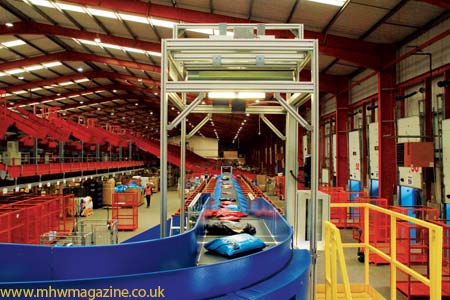
Hermes is the UK's largest home delivery courier network handling more than
160 million collections and deliveries each year. Hermes provides a range of
flexible and affordable delivery options to home, work, a neighbour, safe
place, store or ParcelShop at a time or day that is suitable for the
consumer and fits within their increasingly busy lifestyles.
This multi-channel approach offers a convenient and hassle-free delivery
experience that achieves high levels of satisfaction and ultimately creates
brand value.
Within the UK, Hermes operates a network of over 7,500 lifestyle couriers
that provides high-quality doorstep delivery. This flexible, friendly and
local approach means that couriers understand the habits and preferences of
individual customers, ensuring that up to 95 per cent of parcels are
delivered first time.
Hermes has in recent years diversified from agency catalogue brands to work
with a wide range of leading high street, catalogue and online retailers in
the UK including Next Directory, sit-up channels, ASOS, QVC, Tesco, John
Lewis, New Look, Debenhams, Arcadia Group, JD Williams, Damart, Lakeland
Limited and M&M Direct.
In Germany, the Hermes Logistik Gruppe (HLG) has become the country's
largest independent home delivery service in the B2C and C2C sectors.
In their strategic planning Hermes identified that the new business that
Hermes is winning means that pressure would be put on the existing
automation infrastructure. To cope with this expected increase of throughput
Hermes decided on a strategy of optimisation of their automatic sorting
systems by targeting the types and sizes of the items being sorted. Their
thoughts were that if they could identify the number of small parcels,
bagged and flats that were going through their two existing shoe sorters,
then they could design a new system to remove these items and sort them
separately thereby freeing up more space on their bigger sorters for the
larger items.
The application involved the design of a new system to handle these small
parcels, bagged and flat items. This involved the installation of a new
vertical cross belt sorter, opening six new induct doors, five new extending
boom conveyors and a new conveyor system.
One of the criteria imposed on the system was that the system had to have a
small footprint as space was at a premium. This was achieved by installing a
vertical cross belt sorter from Interroll feeding into cages instead of down
chutes. Other criteria were that the system needed to be capable of sorting
6,000 items/h and this was achieved with a conveyor speed of 1.7 ms. The
system is capable of sorting to 36 cage positions which equate to 36
destinations. However there is the possibility of having multiple
destinations in one cage or multiple cages for one destination, this is due
to the difference in the amounts of business done at each destination.
Also as part of the overall criteria was the need for reliable and accurate
data capture. To achieve this Hermes turned to Vitronic GmbH who had
previously installed two multisided camera barcode reading systems on the
two existing shoe sorters.
Peter Jones, Hermes' Projects Engineering Manager stated that "The two
multisided systems on the existing sorters have now been in operation for
three years and have given us no problems and excellent read rates. Because
of this we decided that VITRONIC should be asked to supply the new camera
system."
As part of the new project VITRONIC was asked to supply a top reading camera
system with volume measurement to the same standards as the previous
systems. This involved the installation of a camera system that would tackle
the problem of reading barcodes on bagged items and items covered with
foils.
In the previous camera systems, VITRONIC had provided two VIPAC R5 - six
camera five sided reading systems, which included two top cameras looking at
different angles to the items. This would enable the cameras to read the
barcodes from two different views enabling the capture of wavy barcodes or
barcodes with foil creating reflections. This idea was also adopted in the
new system so we installed a VIPAC R1 - two camera system. Also included in
the camera system was the VITRONIC "Web viewer" software which enables a
person to log into the system from anywhere in the world via "Web" enabled
devices.
The "Web viewer" software enables the retrieval of information and operator
interfaces such as:
• System status
• System faults
• Hub statistics
• Image retrieval
• Image Archiving
• Barcode validation
• Barcode Configuration
• Image export
Peter Jones also stated "The new camera system is now installed and running
with the same reliability as the previous two systems. The read rates are
better than expected and throughputs we are currently achieving are
consistently above our expectations.